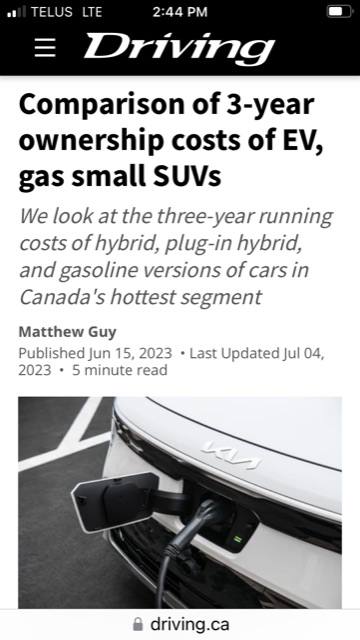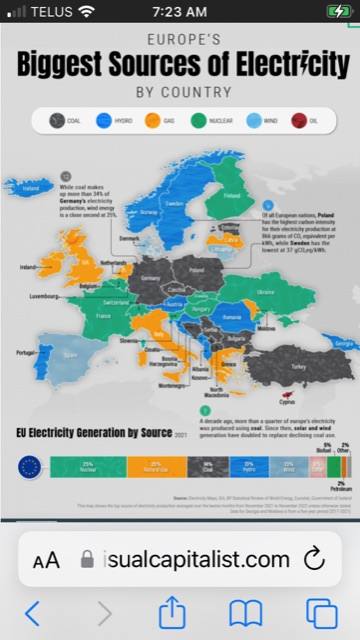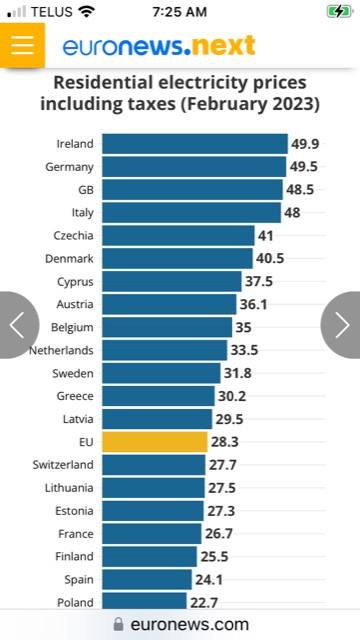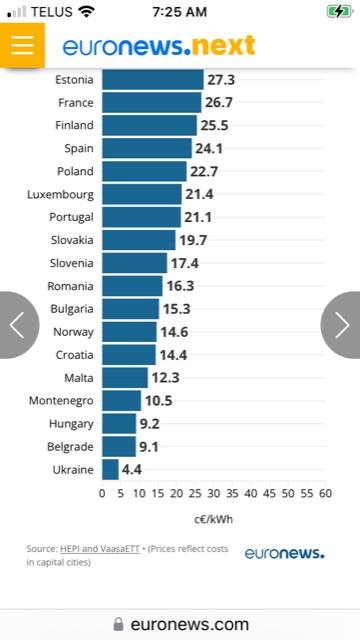Originally posted by AlbertaFarmer5
View Post
Announcement
Collapse
No announcement yet.
Welcome to Canada, the land of free roads, cheap gas – and the world’s least fuel-eff
Collapse
Logging in...
Welcome to Agriville! You need to login to post messages in the Agriville chat forums. Please login below.
X
-
Don’t bring in actual facts. I was listening to our Premier being interviewed on QR 770 this morning. To reclaim one windmill, remove concrete and remediate is $750000 today. Imagine a field with 25 windmills, $18.75 million. What will that cost be in 10 years? And wind is really rocking today producing at 2.5% of capacity. Quite hot, need to power those air conditioners!! But not with wind apparently!!
-
You think that's bad. Check out Texas during this recent heat wave. Wind has been producing almost nothing. They've been on the verge of blackouts everyday.Originally posted by Hamloc View PostDon’t bring in actual facts. I was listening to our Premier being interviewed on QR 770 this morning. To reclaim one windmill, remove concrete and remediate is $750000 today. Imagine a field with 25 windmills, $18.75 million. What will that cost be in 10 years? And wind is really rocking today producing at 2.5% of capacity. Quite hot, need to power those air conditioners!! But not with wind apparently!!
Comment
-
I get the impression that Chuck doesn't understand why electric vehicles are coal powered. Every electric vehicle added to the grid is additional demand which didn't used to exist, which requires new generation. As we have established, wind and solar are useless. Chuck's wing nut environmental friends won't allow any new hydro or nuclear. Many areas won't allow fracking. LNG is prohibitively expensive compared to coal.
Even if more solar and wind are built, every last what needs to be backed up with dispatchable.
In most of the world, the only option left is coal. North America being the exception where it will be natural gas.
Comment
-
80% emission free electricity in Canada including nuclear, hydro and renewables but you still complain about how EVs are going to use coal in Canada? LOL
All 3 prairie provinces including Manitoba are planning on lots more renewables to increase generation capacity.
Even if EVs are charged with fossil fuel plants, they are are still more efficient than ICE engines.
EVs are 80% efficient vs 20% for ICEs.
Fossil power plants are more efficient than ICEs by a long way around 50% and EVs still help reduce emissions and other forms of air pollution.
Mine is costing $2.00 per 100km of electric vs $8.00 for 100 km of gasoline. And the gas ICE was only 20% efficient. Which is more efficient again? LOLLast edited by chuckChuck; Aug 30, 2023, 07:51.
Comment
-
When the oil and gas runs out the well is abandoned.Originally posted by Hamloc View PostDon’t bring in actual facts. I was listening to our Premier being interviewed on QR 770 this morning. To reclaim one windmill, remove concrete and remediate is $750000 today. Imagine a field with 25 windmills, $18.75 million. What will that cost be in 10 years? And wind is really rocking today producing at 2.5% of capacity. Quite hot, need to power those air conditioners!! But not with wind apparently!!
When will the sun and the wind run out? Never!
You can put another more efficient wind mill or solar panel on the same site multiple times.
And the oil industry is trying hard not to pay the the billions of dollars required to clean up all their tens of thousands of sites when the oil runs out or has already run out.
Comment
-
Canada Represents 0.48% of the world's population. Why do you continue to cherry pick this one irrelevant country, and pretend that it represents the entire world? The rest of the world is building coal plants.Originally posted by chuckChuck View Post80% emission free electricity in Canada including nuclear, hydro and renewables
Even within canada, we will never build another hydro dam, the only feasible renewable energy source available, as long as you and your anti environment friends keep opposing all hydro. The only thing left is fossil fuels. For now in North America, that is clean natural gas. Your Green loon friends also want to ban fracking. That will literally leave coal as the only option available to power an industrial society.Last edited by AlbertaFarmer5; Aug 30, 2023, 13:52.
Comment
-
Hmmm, say what you will in this test of many models, even with $8000 of government subsidies and cheaper fuel still more expensive to own. Never mind the fact that an equivalent EV model is 35-46% heavier.Originally posted by chuckChuck View Post80% emission free electricity in Canada including nuclear, hydro and renewables but you still complain about how EVs are going to use coal in Canada? LOL
All 3 prairie provinces including Manitoba are planning on lots more renewables to increase generation capacity.
Even if EVs are charged with fossil fuel plants, they are are still more efficient than ICE engines.
EVs are 80% efficient vs 20% for ICEs.
Fossil power plants are more efficient than ICEs by a long way around 50% and EVs still help reduce emissions and other forms of air pollution.
Mine is costing $2.00 per 100km of electric vs $8.00 for 100 km of gasoline. And the gas ICE was only 20% efficient. Which is more efficient again? LOL

Comment
-
This reminds me of that poster who continuously claims that wind and solar are the cheapest generation sources. In spite of the fact that every single time they have been installed at scale, and in spite of the massive subsidies, it results in higher electricity costs, and he cannot find even a single exception to that.Originally posted by Hamloc View PostHmmm, say what you will in this test of many models, even with $8000 of government subsidies and cheaper fuel still more expensive to own. Never mind the fact that an equivalent EV model is 35-46% heavier.
 Last edited by AlbertaFarmer5; Aug 30, 2023, 17:02.
Last edited by AlbertaFarmer5; Aug 30, 2023, 17:02.
Comment
-
Wrong again A5? At least you are consistent.
https://www.imf.org/en/Publications/WP/Issues/2022/11/04/Chasing-the-Sun-and-Catching-the-Wind-Energy-Transition-and-Electricity-Prices-in-Europe-525079
Chasing the Sun and Catching the Wind: Energy Transition and Electricity Prices in Europe
Summary:
European power markets are in the midst of unprecedented changes, with a record-breaking surge in energy prices.This paper investigates the impact of green power resources on the level and volatility of wholesale electricity prices at a granular level, using monthly observations for a panel of 24 European countries over the period 2014–2021 and alternative estimation methods including a panel quantile regression approach. We find that renewable energy is associated with a significant reduction in wholesale electricity prices in Europe, with an average impact of 0.6 percent for each 1 percentage points increase in renewable share. We also find evidence for a nonlinear effect—that is, higher the share of renewables, the greater its effect on electricity prices. On the other hand, while quantile estimation results are mixed with regards to the impact of renewables on the volatility of electricity prices, we obtain evidence that renewable energy has a negative effect on volatility at the highest quantiles. Overall, our analysis indicates that policy reforms can help accelerate the green transition while minimizing the volatility in electricity prices.
Comment
-
https://energy5.com/understanding-alberta-current-power-rates-what-you-need-to-know
The Impact of Renewable Energy on Alberta Power Rates: An Overview
If you live in Alberta, Canada, you may have noticed your power rates have been fluctuating. This is due, in part, to the growing prevalence of renewable energy sources in the province. Renewable energy is energy generated from sources that can be naturally replenished, such as solar, wind, hydroelectric, and geothermal power. As the use of renewable energy increases, it's important to understand its impact on power rates in Alberta.
Renewable Energy in Alberta
Renewable energy has been gaining traction in Alberta in recent years. In 2017, the province announced a goal to generate 30% of its electricity from renewable sources by 2030. This goal was later increased to 50% in 2019. To achieve this target, Alberta has implemented various policies and programs to encourage the growth of renewable energy, such as:
The Renewable Electricity Program, which invites proposals for new renewable energy projects through a competitive process.
The Climate Leadership Plan, which includes a price on carbon and an accelerated phase-out of coal-fired electricity generation.
The Micro-Generation Regulation, which allows Albertans to generate their own electricity from renewable sources and sell any excess power back to the grid.
Impact on Power Rates
The growing use of renewable energy in Alberta has had a noticeable impact on power rates. While it's difficult to determine the exact amount of this impact, there are several factors that contribute to the relationship between renewable energy and power rates:
Low operating costs: Renewable energy sources such as wind and solar have low operating costs compared to traditional fossil fuel sources, which can lead to lower power rates.
Increased competition: With the introduction of the Renewable Electricity Program, there has been increased competition among renewable energy providers, which can lead to lower rates.
Infrastructure costs: While renewable energy sources may have low operating costs, the infrastructure costs associated with building and maintaining renewable energy facilities can be high. These costs may offset some of the savings from operating costs.
Market fluctuations: Power rates in Alberta are subject to market fluctuations, which may be influenced by factors such as oil prices, weather patterns, and supply and demand. These factors can impact the relationship between renewable energy and power rates.
Key Takeaways
The growing use of renewable energy in Alberta has had a noticeable impact on power rates, influenced by variables such as low operating costs, increased competition, infrastructure costs, and market fluctuations. As renewable energy continues to play a larger role in the province's energy mix, it's important for Albertans to understand the relationship between renewable energy and power rates.
Overall, the impact of renewable energy on power rates in Alberta is a complex issue. While it can lead to lower rates in some cases, there are also factors that may offset these savings. As the province continues to strive towards its renewable energy goals, it's important to carefully consider the impact on power rates and work towards achieving a sustainable and affordable energy future.
Comment
-
The energy transition is the new gold rush and investors play an essential role
Mark D. Wiseman
https://www.theglobeandmail.com/business/commentary/article-the-energy-transition-is-the-new-gold-rush-and-investors-play-an/
"With the continuing electrification of the construction, transport and industrial sectors, the growth rate of electricity already surpasses those of oil, gas and coal. What’s more, increasing digitization across industries has led to a surge in data flow, processing, storage and server capacity, further amplifying electricity requirements.
In order to meet this insatiable demand for electric power, governments everywhere are backing the shift toward renewables. The United States has offered unprecedented incentives for new renewable infrastructure investments through its Inflation Reduction Act. Canada is in hot pursuit. Europe’s major economies have been, and will continue to be, hubs for low-carbon energy development in wind, solar, nuclear and certain forms of hydrogen production.
And it’s not just the West. In 2022, China’s investments in renewable energy surpassed those of the United States by nearly four times, at US$546-billion. This is the same country that is producing and exporting more electric vehicles than anywhere else in the world. Even Saudi Arabia, one of the most fossil-fuel-dependent economies on earth, plans to generate half of its electricity from renewables by the close of the decade, and is undertaking a broad government-led effort to diversify its economy.
Comment
- Reply to this Thread
- Return to Topic List



Comment